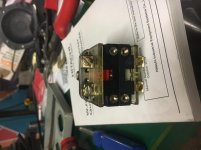upthebikes
Cast Iron
- Joined
- Aug 23, 2007
- Location
- Great Lakes USA
Hi all - set up my first VFD (hitachi wj200) and it works well so far during testing. I have an older 30mm furnas (now eaton) 3 way rotary selector i’d like to use to control fwd / off / reverse for the spindle. The rotary selector has 1 52baj contact block and 1 52bak contact block mated to a 52sa2cab selector. so I have one NO contact block with two terminals, one NC contact block with two termjnals and a 3 position maintained switch. I think this is the proper set-up.
I wired in a speed pot OK, so I am familiar with the programming and selecting the external logic control from the drive. I am not sure how to physically wire this 3 way switch, as simple as it might be.
Logic input 1 is fwd run ON/OFF, logic input 2 is rev run ON/OFF. I am guessing I have to jumper the switch between 2 terminals of the blocks on the switch? And where would I need to terminate the grounding wire (from the multiconductor shielded cable)?
Thank you in advance. I’ll try to post a picture of the block but recently I know there have been problems with the forum.
I wired in a speed pot OK, so I am familiar with the programming and selecting the external logic control from the drive. I am not sure how to physically wire this 3 way switch, as simple as it might be.
Logic input 1 is fwd run ON/OFF, logic input 2 is rev run ON/OFF. I am guessing I have to jumper the switch between 2 terminals of the blocks on the switch? And where would I need to terminate the grounding wire (from the multiconductor shielded cable)?
Thank you in advance. I’ll try to post a picture of the block but recently I know there have been problems with the forum.



